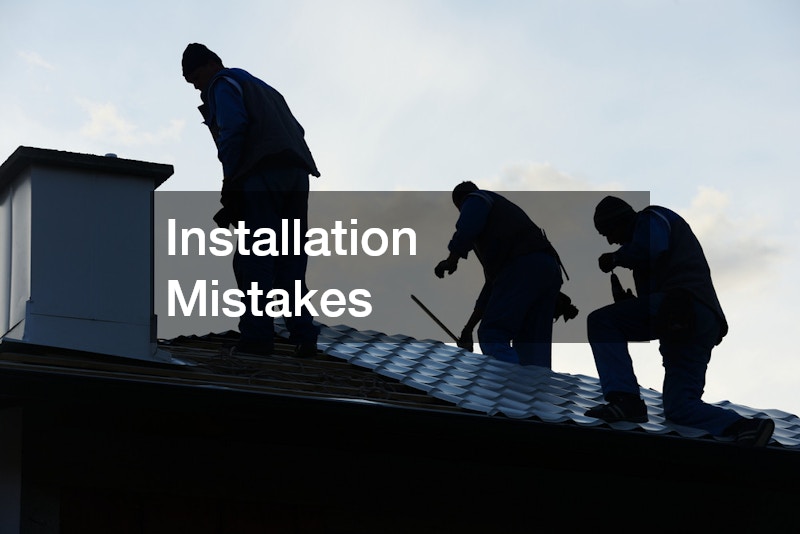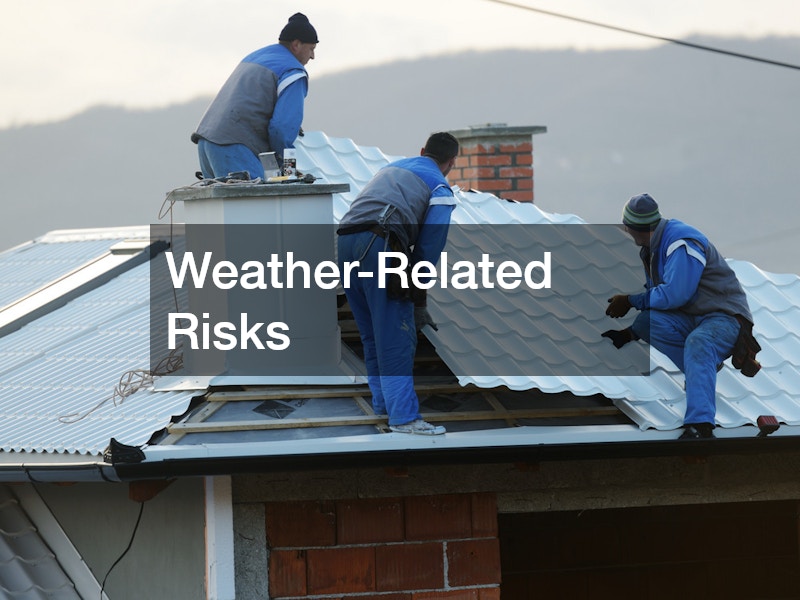Roof replacement is a major investment for any property owner, whether managing a residential or commercial project. Understanding what can go wrong during a roof replacement is essential to avoid costly mistakes, extended timelines, and unnecessary stress. Even when using high-quality materials and hiring experienced contractors, roofing projects carry inherent risks that can affect the final outcome. From structural damage to scheduling delays, homeowners and contractors must anticipate potential issues to ensure a smooth replacement process.
Choosing the right team, including roofing companies, local tree service providers, and siding companies, as well as coordinating crane rental and construction equipment, plays a critical role in the overall success of the project. Integrating services such as gutter installation and ensuring compatibility of metal roofing or fortified roofing materials with the existing structure can prevent long-term complications.
This article explores what can go wrong during a roof replacement, detailing common errors, their causes, and strategies for prevention. By understanding potential pitfalls and how to address them proactively, homeowners can protect their investment and maintain peace of mind throughout the project.
Common Material Issues
Low-Quality Materials
One of the most frequent issues in roof replacement involves the use of substandard or inappropriate materials. Poor-quality shingles, underlayment, or metal roofing panels can compromise durability and lead to premature wear. Even if the installation is technically correct, inferior materials reduce the lifespan of the roof and increase ongoing maintenance costs. Contractors must evaluate supplier reputations and product warranties carefully to avoid this problem.
Incompatible Materials
Materials that do not match the existing structure or climate requirements can create long-term problems. For example, certain fortified roofing products may not withstand high humidity or heavy snowfall, leading to leaks and structural stress. Homeowners should discuss material suitability with their contractors before purchasing to ensure compatibility with local conditions.
Delays in Material Delivery
Construction timelines can be disrupted when essential materials are delayed. Scheduling conflicts often occur if contractors must wait for specialized items such as fortified roofing panels or custom gutter installation components. These delays can impact other aspects of the project, including labor availability and equipment scheduling.
Hidden Defects
Even high-quality products may have hidden defects. Warped shingles or damaged flashing may not be visible until after installation, requiring costly replacements or repairs. Regular inspection upon delivery and prior to installation can mitigate these risks.
Storage and Handling Issues
Improper storage of roofing materials can lead to damage before installation. Exposure to moisture, sunlight, or rough handling during crane rental and unloading can weaken the materials and compromise their effectiveness. Contractors must plan secure storage and careful transport to maintain material integrity.
Installation Mistakes

Poor Shingle Alignment
Incorrect alignment of shingles or panels affects both aesthetics and performance. Misaligned metal roofing panels can create gaps, leading to leaks and reduced structural integrity. Ensuring proper layout and measurement before installation prevents long-term problems and enhances visual appeal.
Incorrect Fastening Techniques
Using improper nails, screws, or fasteners can cause panels to loosen over time. Even minor errors in fastening techniques may result in major issues, particularly during storms or high winds. Contractors should follow manufacturer specifications and double-check each attachment to prevent failures.
Inadequate Underlayment
Underlayment serves as a protective barrier against moisture. Skipping or improperly installing this layer can result in water infiltration, damaging the roof deck and interior spaces. This is particularly critical in residential roofing projects where interior finishes can be affected.
Flawed Flashing Installation
Flashing around chimneys, vents, and valleys is critical for preventing leaks. Poorly installed flashing is a common cause of water damage and can compromise the effectiveness of residential roofing projects. Careful attention to detail and high-quality flashing materials reduce the risk of future problems.
Rushed Work
Rushing installation to meet tight deadlines often leads to mistakes. This can affect every aspect of the project, from roofing companies mishandling panels to construction equipment being misused. Slower, methodical installation improves overall quality and reduces the likelihood of what can go wrong during a roof replacement.
Structural Problems
Damaged Roof Deck
A weakened or rotted roof deck is a major concern that may not be visible until the old roof is removed. What can go wrong during a roof replacement in this scenario includes sagging panels and compromised support for new materials. Inspecting the deck thoroughly and making necessary repairs ensures long-term stability.
Inadequate Support for Heavy Materials
Heavy metal roofing or fortified roofing may require additional reinforcement. Failing to support these materials properly can lead to sagging or collapse over time. Structural engineers or experienced contractors should assess load capacity before installation.
Improper Ventilation
Incorrectly installed vents can trap moisture and heat, causing damage to both the roof and interior areas. Proper ventilation planning prevents mold growth and wood rot, and reduces energy efficiency.
Roof Slope Issues
Roof pitch affects drainage and material performance. If the slope is miscalculated or altered during replacement, water may pool and cause leaks or structural stress. Contractors must verify slope measurements and drainage plans before installation.
Unstable Roofing Substrate
The substrate beneath the roofing material must be stable and properly prepared. Weak or uneven surfaces can create stress points, reducing the lifespan of even high-quality residential roofing. Reinforcing or leveling the substrate helps avoid premature failures.
Weather-Related Risks

Storm Delays
Rain, snow, or high winds can halt roofing projects, leaving partially installed fortified roofing vulnerable to damage. Contingency planning and flexible schedules help mitigate these delays and reduce stress on contractors and homeowners.
Temperature Fluctuations
Extreme temperatures affect adhesives, sealants, and shingles. Improper handling during installation can cause materials to expand or contract incorrectly, leading to gaps and potential leaks. Weather monitoring is essential for safe and effective installation.
Moisture Intrusion
Rain or humidity during replacement can allow water to seep into the structure, damaging the roof deck and interior ceilings. Covering exposed areas and planning work around dry weather reduces this risk.
Ice Damming
In colder climates, improper insulation or ventilation can lead to ice dams that trap water and cause leaks. Coordination with local tree service providers to manage shade and snow accumulation can help prevent ice-related damage.
Wind Damage
High winds during installation can displace shingles or metal roofing panels, particularly if not securely fastened. Ensuring fastener compliance with manufacturer recommendations and using proper crane rental techniques reduces this hazard.
Safety Concerns
Falls From Heights
Roof replacement is inherently dangerous. Proper use of scaffolding, harnesses, and crane rental equipment is critical to prevent falls. Comprehensive safety plans and training reduce the risk of accidents.
Equipment Malfunction
Faulty construction equipment can lead to injuries or project delays. Routine inspection and preventive maintenance ensure that tools operate safely throughout the project.
Electrical Hazards
Working near overhead lines or existing electrical systems requires coordination with licensed contractors. Accidental contact can result in injury, fire, or damage to electrical systems.
Improper Ladder Use
Ladders must be stable and correctly positioned. Improper use is a common cause of on-site injuries during residential roofing projects. Regular ladder safety training and supervision prevent accidents.
Inadequate Safety Training
Teams that are not trained in safety protocols may overlook hazards, putting workers and homeowners at risk. Safety certifications, supervision, and clear communication reduce potential liabilities.
Coordination Challenges
Scheduling Conflicts
Multiple trades, including siding companies, a local paving contractor, and a local tree service, must be coordinated effectively to prevent delays. Advanced scheduling software or project management systems can help streamline timelines.
Miscommunication Among Contractors
Poor communication can result in errors, such as incorrectly installed materials or overlooked tasks, affecting overall project quality. Weekly meetings and clear documentation improve clarity and reduce mistakes.
Overlapping Projects
When multiple projects occur simultaneously on the property, such as landscaping or exterior renovations, timing conflicts can create bottlenecks. Strategic planning prevents interference with roofing work.
Inspection Delays
Municipal inspections or contractor reviews can slow progress if not scheduled in advance. Coordinating inspections with the project timeline ensures timely approvals and reduces downtime.
Permitting Issues
Failure to obtain proper permits can halt construction and lead to legal complications, delaying completion. Ensuring all permits are secured before work begins is a key preventive measure.
Budget Overruns

Unexpected Repairs
Discovering hidden damage, such as a weakened roof deck or faulty flashing, can increase costs unexpectedly. A thorough pre-installation inspection reduces these surprises.
Material Price Fluctuations
Market changes can raise costs for essential items like metal roofing, fortified roofing, or gutter installation components. Planning for price contingencies helps maintain the budget.
Labor Cost Increases
Extended project timelines due to what can go wrong during a roof replacement can inflate labor expenses. Detailed scheduling and realistic timelines help control labor costs.
Equipment Rental Fees
Additional crane rental or construction equipment use can add unplanned costs. Early planning and accurate estimates minimize unexpected expenditures.
Change Orders
Client-requested changes during installation often result in extra charges, particularly for premium materials or specialized services. Clear contracts and communication reduce disputes and additional costs.
Environmental and Site Issues
Tree Interference
Branches from nearby trees may obstruct work, damage materials, or require a local tree service to manage safely. Proactive trimming and planning prevent delays.
Soil Stability
Unstable ground can affect scaffolding and equipment placement, creating hazards and slowing progress. Soil assessments and proper leveling improve site safety.
Water Runoff
Improper drainage during installation may lead to flooding or erosion, impacting both the roof and surrounding property. Coordinating gutter installation with the roofing project helps manage runoff effectively.
Wildlife Encounters
Birds, squirrels, or other animals can interfere with materials or nesting areas, especially in older homes. Temporary barriers or pest management reduce interruptions.
Neighboring Property Risks
Falling debris or equipment mishandling can cause damage to adjacent properties, creating liability concerns. Protective measures and careful crane rental operation help prevent accidents.
Post-Installation Problems
Leaks and Water Damage
Even minor installation errors can lead to leaks, requiring additional roofing companies to fix issues. Routine inspections immediately after completion help identify problems early.
Settling and Shifting
Materials may settle over time, causing uneven surfaces or gaps in metal roofing or shingles. Proper installation and periodic checks reduce long-term complications.
Gutter Issues
Improper gutter installation can redirect water toward the foundation, causing long-term damage. Aligning gutters with the roof slope and drainage plans prevents erosion and water intrusion.
Siding Damage
Poor coordination with siding companies can result in scratches, dents, or misaligned panels. Scheduling work carefully and protecting adjacent surfaces is essential.
Warranty Complications
Neglecting documentation or manufacturer instructions can void warranties, leaving homeowners responsible for repair costs. Maintaining records and following installation guidelines ensures coverage remains valid.
Choosing the Right Professionals

Research and References
Selecting reputable roofing companies ensures expertise and reliability. Homeowners should check reviews, ask for references, and review past projects to confirm credibility.
Licensing and Insurance
Licensed contractors with proper insurance protect homeowners against liability and substandard work. Confirming credentials before hiring prevents legal and financial complications.
Specialized Services
Depending on the project, hiring a local tree service, siding companies, or local paving contractor can prevent complications and ensure smooth workflow.
Equipment and Resources
Access to proper construction equipment and crane rental ensures efficient and safe installation of materials like fortified roofing and metal roofing. Contractors with the right tools can complete work faster and more accurately.
Clear Contracts
Detailed contracts outlining materials, timelines, and responsibilities reduce misunderstandings and protect all parties involved. This is particularly important when coordinating multiple contractors and specialized services.
Preventive Measures
Pre-Installation Inspection
Inspecting the roof deck, ventilation, and existing structures identifies hidden issues before installation begins. Early detection allows for timely repairs and reduces surprises during the project.
Material Verification
Confirming that all metal roofing or fortified roofing products meet quality standards and are suitable for the project prevents future problems.
Weather Planning
Scheduling work around seasonal weather patterns reduces exposure to rain, snow, or high winds, preventing delays and material damage.
Communication Protocols
Maintaining clear lines of communication among roofing companies, contractors, and suppliers avoids errors and ensures everyone understands their responsibilities.
Routine Monitoring
Regularly monitoring the project during installation allows for immediate correction of mistakes, preventing long-term damage and ensuring high-quality workmanship.
Understanding what can go wrong during a roof replacement is key to a successful project. From material selection and installation errors to structural issues, weather challenges, and coordination problems, there are multiple areas where mistakes can occur. By proactively addressing these risks, hiring reputable roofing companies, and coordinating services like local tree service, siding companies, a local paving contractor, crane rental, and gutter installation, homeowners can significantly reduce complications.
Choosing high-quality materials such as metal roofing or fortified roofing, alongside careful planning and proper construction equipment, ensures a durable and safe roof replacement. Being informed, prepared, and vigilant throughout the project protects the home, investment, and peace of mind, turning a complex task into a smooth and successful endeavor. Proactive management, attention to detail, and hiring experienced professionals make all the difference in preventing issues and achieving a long-lasting roof.
